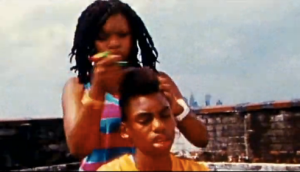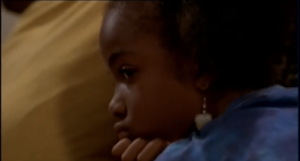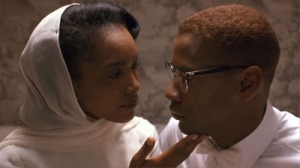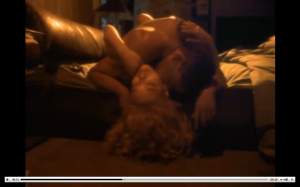Spike Lee’s films have been known to touch on a variety of topics and realities in society in the most blunt and honest ways. In class we’ve often talked about the amount of passion and feeling behind some of the topics approached in his films describing moments that are painful to watch but at the same time funny while recognizing the fact that Spike Lee is not laughing. When it comes to womanhood though it’s interesting because where Lee stands is sometimes questionable and confusing. He deals with womanhood in many of his films sometimes choosing to depict women as queen’s, saviors, supporters, and free thinkers, but in many instances as one dimensional characters whose depth is seen through the men they follow behind. Here’s our collection of post from our classmates and ourselves that take a look at and draw attention to the many depictions of womanhood through Spike Lee’s joints.
Table of Contents:
Malcolm X
This post highlights an article that pointed to the lack of conversation about gender in the nation of Islam and more specifically womanhood in the nation of Islam as well as with Malcolm X. Using in outside source for reference, this article shines a light on Spike Lee’s directorial decision to represent women as simply the support system to the patriarchal male in the form of Betty Shabazz and Malcom X when that wasn’t the complete case in their story.
-Taken from Spike Lee Joints 3
Re: Malcolm X
A movie that I found that spoke somewhat indirectly about gender was “Malcolm X”, and I chose this post because it introduced the idea, while using outside research to bolster the point. For me, Lee’s decision to not explicitly explore the idea of gender while discussing the issue of race seemed a poignant directorial choice, and I wanted to understand in greater depth, the reasons he made the choices he did, and perhaps, what would have been at stake had he spoken more truthfully about various incidents. For me, Lee’s circumventing the issue of “Womanhood” spoke volumes to me about the aspect as it’s portrayed in his films.
-Written by Mercedes MacAlpine
Black Women in Mo’ Betta Blues
Black Women in Mo’ Betta Blues challenges Spike Lee’s inclination to depict black women as either the queen or the savior in his films by highlighting the manner in which these identities are in the context of men. Through the use of Mo’ Betta Blues as the primary example, hudso22k points at the band mates use of the term queen in regards to their women while at the same time objectifying them as well Bleek’s use of Indigo as his savior in the end. This post highlights the manner in which Spike Lee is quick to depict womanhood as being able to fit into the category of queen or savior, which is problematic when this identity is “not from the context of or for the good of a woman but of and for a man.”
-Taken from Spike Lee Joints 3
Aunt Song as a Role Model for Troy
We chose this blog post because it talks about Troy having a certain maturity in relation to other children and women in Spike Lee’s films and it also talks about the personal growth she garners from spending the summer with her aunt and uncle. This blog post makes an interesting argument that even though Troy is not yet physically developed enough to be a woman or assume womanhood, she must assume a role of motherhood (which is an aspect of womanhood) once her mother dies.
-Taken from Spike Lee Joints 2
Troy, the Caretaker
This post was chosen because it supports the notion from “Aunt Song as a Role Model for Troy” which argues that Troy was forced into roles of womanhood due the death of her mother. This post visually makes the argument that Troy undergoes a transition from child to caretaker. The first image is Troy in her father’s lap crying because of her mother’s death and the second image is Troy’s little brother in her lap getting his hair picked out by her.
-Taken from Spike Lee Joints 2
On Not Wanting to Be Alone Tonight
Through Liz’s comparison of Destiny Child’s hit, “Cater 2 U” and the Gamma Rays’ performance at the homecoming showcase, we can see the manifestation of “womanhood” as defined by the entertainment industry in mainstream culture. Sexually appealing and on display, both groups seem to be inviting the viewer to feast their eyes, yet Destiny’s Child’s reputation as being a performance group filled with strong “independent” women, creates a tension that is absent in The Gammas’ performance. Does this tension make them more covetable? Is their independence merely a farce that is overlooked in the grand scheme of their appearance? How lucrative is the idea of a woman who owns her womanhood? These are some of the questions that we engaged with in this post.
-Taken from Spike Lee Joints 1
Spike Lee’s Conception of Black Womanhood Through the Use of Physical Markers: Hair as as a Reflection of Womanhood
Spike Lee’s School Daze, provides his commentary on womanhood by utilizing Jane, a character that represents a perceived black femininity and “womanhood” through reliance on European beauty values and Rachel, a character that stays natural and represents black womanhood and promotes racial empowertment. This is examined through the dichotomy of the Jigaboos and Wannabees with specific interest in the physical marker of hair as well as the differential sexual portrayal of Jane and Rachel. Ultimately, the problematic nature of viewing and basing womanhood on physical attributes and men’s preferences is examined.
Written by Millicent Gordon
What defines Womanhood?
This post is a response to the interpretations of womanhood in “Aunt Song as a Role Model for Troy”, “Troy, the Caretaker”, and “On Not Wanting to Be Alone Tonight”. I was interested in the different definitions associated with womanhood because when I started thinking about the topic, I realized that I did not have a clear understanding of the womanhood. This post takes both interpretations of womanhood and uses them together to come to a conclusion on womanhood and its distinguishing qualities.
-Written by Coralie Pardo
To Praise or To Punish?
This post cites an article written in the Root in 2009 that took an in-depth look at depictions of womanhood in Spike Lee films over the years. The article calls attention to Spike Lee’s contradictory and problematic decisions for women as well as his chauvinistic attitude towards his films. It’s in interesting perspective looking back on these films that caused so much buzz when they first appeared. The article’s title “Do The Right Thing at 20: Spike’s Women Problem” sums up the overall idea behind the article.
-Written by Kristen Harris







